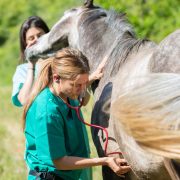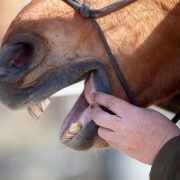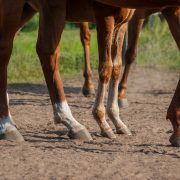Nonstrangulating intestinal infarctions associated with Strongylus vulgaris: Clinical presentation and treatment outcomes of 30 horses (2008–2016)
Nonstrangulating intestinal infarctions associated with Strongylus vulgaris: Clinical presentation and treatment outcomes of 30 horses (2008–2016)

Requires membership/payment
This article can be accessed via RCVS Knowledge Library Membership (click here).
In our edition of: Feb 2018
In our categories of: equine
our summary:
Pihl, T.H. et al. (2018) Nonstrangulating intestinal infarctions associated with Strongylus vulgaris: Clinical presentation and treatment outcomes of 30 horses (2008-2016). Equine Veterinary Journal, 50 (4) pp 474-480
The prevalence of Strongylus vulgaris in horses has increased in countries with a prescription-only anthelmintic policy. The migration of S. vulgaris larvae within the main branches of the cranial mesenteric artery is known to be associated with nonstrangulating intestinal infarction.
Information on the clinical and laboratory findings of nonstrangluating intestinal infarction is currently lacking and inconsistent.
The aim of this study was to describe the clinical and laboratory findings, treatment and outcome of horses diagnosed with nonstrangulating intestinal infarction.
For this retrospective case series, the medical records of horses with colic admitted to a teaching hospital in Denmark during 2008-2016 were reviewed and selected if they met the case selection criteria associated with nonstrangluating intestinal infarction. Thirty horses were included in the study, 8 mares, 21 geldings and 1 stallion ranging in age from 4 to 15 years.
The most consistent clinical and laboratory findings at admission were: 10 horses had a firm indistinguishable mass and/or were painful when palpated per rectum; 10 had gastric reflux; 21 had increased peritoneal fluid TP; 23 had increased serum SAA concentration; 23 displayed signs of acute systemic inflammatory reaction; 22 had a significantly increased blood lactate concentration; and 22 were tested Elisa-positive for S. vulgaris specific antibodies.
Of the 30 horses included in the study 28 were recommended for exploratory laparotomy, the remaining 2 horses were thought to have primary colitis so were medically treated for this condition. Seven owners declined the recommended surgical option in favour of medical treatment. The remaining 21 horses underwent exploratory laparotomy, 11 horses were euthanised during surgery due to poor prognosis. 9 underwent resection of the infarcted intestine and 1 had disruption of adhesions without resection. Of the 9 horses that had resection of the infarcted intestine, 3 survived to discharge, none of the horses receiving medical treatment or adhesiolysis survived.
Follow up showed that two of 2 of the 3 horses discharged from hospital were alive and no colic had been observed during the 2- and 6-year follow-up period, the third horse was euthanised after its first colic episode 2 years after discharge
Limitations of the study included the small number of horses included and the fact that of those included only 9 underwent resection of the infracted intestine and only 22 had tested ELISA-positive for S. vulgaris specific antibodies.
The re-emergence of nonstrangulating intestinal infarctions caused by S. vulgaris in Denmark is very likely to be associated with the introduction of prescription-only anthelmintics. Veterinary surgeons should be aware of a possible resurgence in the UK when horses are not prescribed anthelmintics.
In areas where S. vulgaris is prevalent nonstrangulating intestinal infarctions should be considered as a differential diagnosis in horses presenting with mild colic and peritonitis.
Image copyright attribute:
valeriylebedev / 123RF Stock Photo








Leave a Reply
Want to join the discussion?Feel free to contribute!